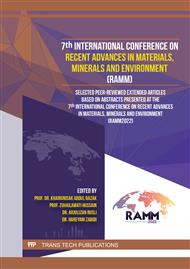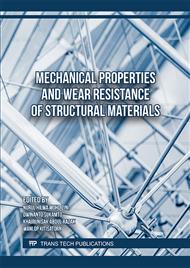[1]
L. E. Murr et al., "Characterization of titanium aluminide alloy components fabricated by additive manufacturing using electron beam melting," Acta Mater., vol. 58, no. 5, 2010, p.1887–1894.
DOI: 10.1016/j.actamat.2009.11.032
Google Scholar
[2]
F. E. Bock, J. Herrnring, M. Froend, J. Enz, N. Kashaev, and B. Klusemann, "Experimental and numerical thermo-mechanical analysis of wire-based laser metal deposition of Al-Mg alloys," J. Manuf. Process., vol. 64, 2021, p.982–995.
DOI: 10.1016/j.jmapro.2021.02.016
Google Scholar
[3]
B. Wu et al., "A review of the wire arc additive manufacturing of metals: properties, defects and quality improvement," J. Manuf. Process., vol. 35, 2018, p.127–139.
Google Scholar
[4]
K. Holmberg, R. Siilasto, T. Laitinen, P. Andersson, and A. Jäsberg, "Global energy consumption due to friction in paper machines," Tribol. Int., vol. 62, 2013, p.58–77.
DOI: 10.1016/j.triboint.2013.02.003
Google Scholar
[5]
N. Saka, A.M. Eleiche, and N.P. Suh, "Wear of metals at high sliding speeds," Wear, vol. 44, no. 1, 1977, p.109–125.
DOI: 10.1016/0043-1648(77)90089-8
Google Scholar
[6]
B.K. Prasad et al., "Sliding wear behavior of some Al-Si alloys: Role of shape and size of Si particles and test conditions," Metall. Mater. Trans. A, vol. 29, no. 11, 1998, p.2747–2752.
DOI: 10.1007/s11661-998-0315-7
Google Scholar
[7]
Z. Chen, X. He, C. Xiao, and S. Kim, "Effect of Humidity on Friction and Wear—A Critical Review," Lubricants, vol. 6, no. 3, 2018, p.74.
DOI: 10.3390/lubricants6030074
Google Scholar
[8]
S.R. Pearson, P.H. Shipway, J.O. Abere, and R. A. A. Hewitt, "The effect of temperature on wear and friction of a high strength steel in fretting," Wear, vol. 303, no. 1–2, 2013, p.622–631.
DOI: 10.1016/j.wear.2013.03.048
Google Scholar
[9]
M. Hirtler, A. Jedynak, B. Sydow, A. Sviridov, and M. Bambach, "A Study on The Mechanical Properties Of Hybrid Parts Manufactured By Forging And Wire Arc Additive Manufacturing," Procedia Manuf., vol. 47,2020, p.1141–1148.
DOI: 10.1016/j.promfg.2020.04.136
Google Scholar
[10]
S. Ponis, E. Aretoulaki, T. N. Maroutas, G. Plakas, and K. Dimogiorgi, "A Systematic Literature Review on Additive Manufacturing in the Context of Circular Economy," Sustainability, vol. 13, no. 11, ,2021, p.6007.
DOI: 10.3390/su13116007
Google Scholar
[11]
C. Sun, Y. Wang, M. D. McMurtrey, N. D. Jerred, and F. Liou, "Additive manufacturing for energy: A review,", Applied Energy, vol. 282, Part A, 2021, 116041.
DOI: 10.1016/j.apenergy.2020.116041
Google Scholar
[12]
R. Warsi, K. H. Kazmi, and M. Chandra, "Mechanical properties of wire and arc additive manufactured component deposited by a CNC controlled GMAW," Mater. Today Proc., vol. 56, Part 5, 2022, pp.2818-2825
DOI: 10.1016/j.matpr.2021.10.114
Google Scholar
[13]
N. Khanna, K. Zadafiya, T. Patel, Y. Kaynak, R. A. Rahman Rashid, and A. Vafadar, "Review on machining of additively manufactured nickel and titanium alloys," J. Mater. Res. Technol., vol. 15, 2021, p.3192–3221.
DOI: 10.1016/j.jmrt.2021.09.088
Google Scholar
[14]
P. Durai Murugan et al., "A current state of metal additive manufacturing methods: A review," Mater. Today Proc., vol. 59, 2022, p.1277–1283.
DOI: 10.1016/j.matpr.2021.11.503
Google Scholar
[15]
A. Vafadar, F. Guzzomi, A. Rassau, and K. Hayward, "Advances in Metal Additive Manufacturing: A Review of Common Processes, Industrial Applications, and Current Challenges," Appl. Sci., vol. 11, no. 3, 2021, p.1213.
DOI: 10.3390/app11031213
Google Scholar
[16]
E. Novianto, P. Tri Iswanto, and M. Mudjijana, "The effects of welding current and purging gas on mechanical properties and microstructure of tungsten inert gas welded aluminum alloy 5083 H116," MATEC Web Conf., vol. 197, 2018, 12007.
DOI: 10.1051/matecconf/201819712007
Google Scholar
[17]
D. Jafari, T. H. J. Vaneker, and I. Gibson, "Wire and arc additive manufacturing: Opportunities and challenges to control the quality and accuracy of manufactured parts," Mater. Des., vol. 202, 2021, 109471.
DOI: 10.1016/j.matdes.2021.109471
Google Scholar
[18]
D. K. Dwivedi, "Wear behaviour of cast hypereutectic aluminium silicon alloys," Mater. Des., vol. 27, no. 7, 2006, p.610–616.
DOI: 10.1016/j.matdes.2004.11.029
Google Scholar
[19]
R. A. Al-Samarai, "Effect of Load and Sliding Speed on Wear and Friction of Aluminum– Silicon Casting Alloy," Int. J Sci. Res. Pub., vol. 2, no. 3, 2012, pp.1-4.
Google Scholar
[20]
R.C. Singh, R. lal Rana, and R. M. Singari, "Investigation of Wear Behavior of Aluminium Alloy and Comparison with Pure Aluminium," International Conference of Advance Research and Innovation (ICARI-2015), 2015, pp.305-314, New Delhi, India.
Google Scholar
[21]
G.W. Stachowiak and A. W. Batchelor, Engineering tribology. Amsterdam; New York: Elsevier, 1993.
Google Scholar
[22]
N. Jeyaprakash and C.-H. Yang, "Friction, Lubrication, and Wear," in Tribology in Materials and Manufacturing - Wear, Friction and Lubrication, A. Patnaik, T. Singh, and V. Kukshal, Eds. IntechOpen, 2021.
DOI: 10.5772/intechopen.87674
Google Scholar
[23]
M.A. Chowdhury, M.K. Khalil, D.M. Nuruzzaman, and M.L. Rahaman, "The Effect of Sliding Speed and Normal Load on Friction and Wear Property of Aluminum," Int. J Mech. Mechatronics Eng., vol. 11, no. 01, 2011, pp.53-57.
Google Scholar



